#concrete or pattern poetry
Link
Women by May Swenson (visual poem)
#social commentaries#gender & sexuality#concrete or pattern poetry#national poetry month#national poetry month day 15#women#may swenson#poetry#poet#visual poetry#national poetry month 2023#april#april 15#april 2023
0 notes
Text

From: Ilse and Pierre Garnier, Poèmes Mécaniques, «Spatialisme» series, supplement of «Les Lettres» magazine, Éditions André Silvaire, Paris, 1965
#graphic design#typography#art#poetry#concrete poetry#visual poetry#pattern#book#ilse garnier#pierre garnier#éditions andré silvaire#les lettres#1960s
315 notes
·
View notes
Text

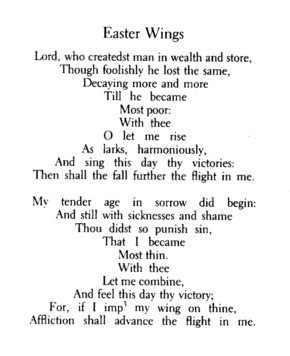
I was actually speechless when my CD showed up today and "But Daddy I Love Him" lyrics stopped me in my tracks. CONCRETE POETRY??
Pattern poetry is probably the more accurate categorization for this ex., but I immediately thought the lyrics echo the shape of one of the most famous examples, "Easter Wings" by George Herbert.
I know the variants have different shapes for the lyrics (circle, square, octagon). But any googling of Concrete Poetry or pattern poetry will inevitably lead you back to the OG George Herbert (or like... ancient Greece, but ignore that for now). I also saw someone on Twitter say that the variants could even symbolize the many interpretations (and no true muse) of this song.
Below is a brief breakdown of "Easter Wings".

On its base level, in "Easter Wings" the speaker meditates on one's relationship to God. I have been thinking, prior to this booklet showing up at my house, that the "him" in BDILH could potentially be God. Or at least one interpretation of it could be. Sunday best, pearl clutching was an early tip off.
Anyway, pattern poetry is more than just shaping a poem into a fun shape or even an obvious shape. The physical shape and visual appearance of how the poem is printed works in combination with the themes and content of the poem to amplify the meaning. It adds another level (a third level?) where the poetry has to be seen to be fully understood. Also because you need to see the poem, authors use its shape to manipulate words, phrases, meanings. Essentially, if you heard the poem it would sound one way, but reading it will reveal the authors true meaning. Dear reader, indeed.
This is an oversimplification, but in "Easter Wings" the wider lines are, to borrow a phrase from "Robin," lighter. The narrowing signifying this turn to despair, pain, disconnect from God. Similarly BDILH lyrics narrow at the most biting part of the song and give way to that incredible running through field energy we end on.
And not for nothing, but the only way I would find the joke of "I'm having his baby, no I'm not," would be if she was talking about God. Lol iykyk.
Anyway, Herbert has another very famous poem. One taught to me in middle or high school - maybe you've seen it before too. It's called "The Altar". The first illustration is harder to read and a little more obvious, the second is how I've seen it reproduced more commonly (still the shape of an altar).


And naturally, the word altar made me think of another song from TTPD... So Long, London.
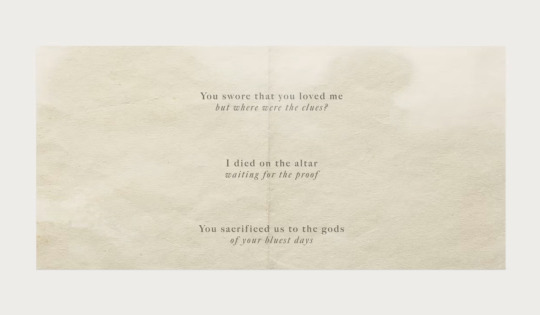
This woman terrifies me...
Anyway, Taylor wants you to put her reading glasses on! Album booklets, lyric videos, the choice is yours! As I always find with her booklets, she fully embraces writing out her lyrics as poetry. You'll notice a lot of changes from the Genius versions, for ex. Album booklet's punctuation, line breaks, new sentences, etc. have changed the entire "meaning" of lines/songs for me. Usually, whatever reframing I find is richer than what I had accepted on the first listen.
I've also noticed how simple the lyric videos for TTPD are in comparison to previous albums, but she's (ok her digital media team who I would not doubt are under STRICT instruction) playing with text quite a bit. Like Herbert above we have many instances of spacing, CAPS, vs lowercase, even collage like effects that completely reorder the lyrics, perhaps even the meaning.
#TTPD#The tortured poets department#taylor swift#but daddy i love him#so long london#george herbert#the altar#easter wings#concrete poetry#pattern poetry#visual poetry#album booklet#TTPD lyric video
6 notes
·
View notes
Text

Alice Corbetta
#Alice Corbetta#product#lighting#light#poetry#bird#pattern#geometric pattern#ethnic#beige#light grey#used#simple#concrete
2 notes
·
View notes
Text

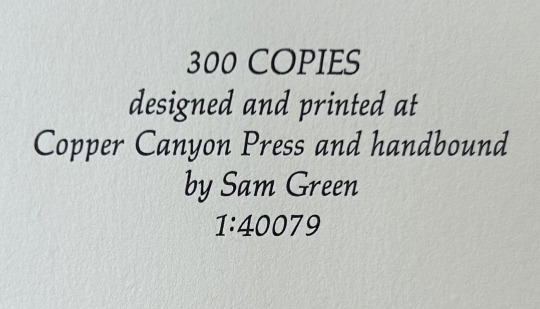
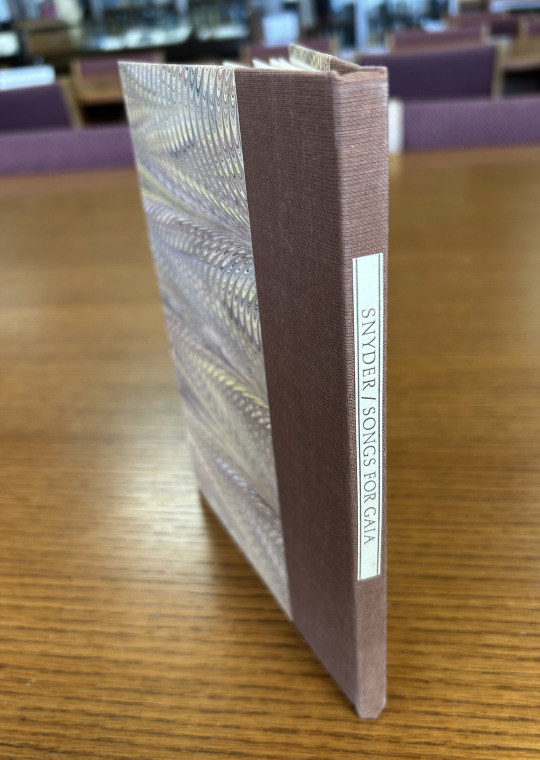







It’s Fine Press Friday!
Today we’re taking a deep dive into Songs for Gaia, a slim edition of poetry by Gary Snyder (b. 1930). This understated, beautifully-crafted letterpress volume was printed in 1979 for Kah Tai Alliance at Copper Canyon in Port Townsend, WA, a fine press dedicated solely to poetry since its founding in 1972, and was handbound by poet and bookbinder Samuel Green. It features woodblock illustrations by poet and printmaker Michael Corr (b. 1940), who learned his craft while living in Kyoto from block printer and illustrator Takeji Asano (1900-1999). Asano was a notable figure in Japan’s Sōsaku-hanga woodblock printing movement. The book is quarter bound in cloth with a cover marbled in a finely executed combed feather pattern, a touch that lends a hint of psychedelia to its otherwise traditional aesthetics. It was released in a limited edition of 300 copies.
Snyder, who is popularly known for his time amongst and spiritualist influence on the Beat poets and the counterculture of their generation (along with Kerouac’s portrayal of him as Japhy Ryder in the 1958 novel The Dharma Bums) spent 13 years in Japan (1956-1968) studying Zen Buddhism, forestry, and ecology. A scholar of Asian languages versed in cultural anthropology, he also studied calligraphy with accomplished calligrapher and seal carver Charles Leong during his time at Reed College. Snyder’s calligraphic signature graces the half-title page of this edition.
This modest yet potent edition of Songs for Gaia is a fitting form for the work of a poet whom writer Bob Steuding once characterized as cultivating an “accessible” style and “a new kind of poetry that is direct, concrete, non-Romantic and ecological.” As Snyder wrote of his own work in A Controversy of Poets, “I try to hold both history and wilderness in mind, that my poems may approach the true measure of things and stand against the unbalance and ignorance of our times.”
View more Fine Press Friday posts
View more woodblock illustration posts
View more marbling posts (shout out to Alice, our resident marbling expert!)
-Ana, Special Collections Graduate Fieldworker
#Fine Press Friday#fine press fridays#marbling#Gary Snyder#poetry#Copper Canyon Press#Songs for Gaia#Samuel Green#Michael Corr#woodblock illustration#woodblock#letterpress#fine press#feather pattern marbling#UWM Special Collections#handbound book#hand binding#Ana
65 notes
·
View notes
Text
So It Goes - Chapter 41: Anarchy
[X]
The hallway exploded.
Concussions rippled and wracked the air, followed a millisecond later by the shredding of glass and metal. Shock waves sent stray bits of shrapnel rocketing past to lodge in the carpet while chunks of concrete catapulted in a spray of dust and battered the walls. Screams; the bang of the starting guns.
The timer started.
I'm nearing the end of this fic, and, well, no more poems after this. (At least, I don't think...) So, I did something a little special for the occasion. Maybe kinda spoilery if you're reading the fic, but if you've played the game, you already know.
Transcript below the cut if you don't want to listen to me read remixed poetry for 4:20. (ha) Not quite formatted correctly since there aren't any justification settings here and I skipped my playing around with blank space, but you get the drift:
The Sailing Rime of J. Alfred Prufrock and The Ancient Mariner's Love Song to Byzantium
I should have been a pair of ragged claws
Scuttling across the floors of silent seas.
To ask a question:
Would you take a bullet for me?
And some in dream assured were
Of the Spirit that plagued us so;
Nine fathom deep he had followed us
From the land of mist and snow.
The self-same moment I could pray,
And from my neck so free
The Albatross fell off, and sank
Like lead into the sea.
Let us go then, you and I...
And would it have been worth it, after all,
Would it have been worth while,
After the sunsets and the dooryards and the sprinkled streets,
After the novels, after the teacups, after the skirts that trail along the floor-
And this, and so much more?-
It is impossible to say just what I mean!
But as if a magic lantern threw the nerves in patterns on a screen:
Would it have been worth while
If one, settling a pillow or throwing off a shawl,
And turning toward the window, should say:
"That is not it at all,
That is not what I meant, at all."
No! I am not Prince Hamlet, nor was meant to be;
Am an attendant lord, one that will do
To swell a progress, start a scene or two,
Advise the prince; no doubt, an easy tool,
Deferential, glad to be of use,
Politic, cautious, and meticulous;
Full of high sentence, but a bit obtuse;
At times, indeed, almost ridiculous-
Almost, at times, the Fool.
That is no country for old men. The young
In one another's arms, birds in the trees,
-Those dying generations- at their song,
The salmon-falls, the mackerel-crowded seas,
Fish, flesh, or fowl, commend all summer long
Whatever is begotten, born, and dies.
Caught in that sensual music all neglect
Monuments of unageing intellect.
I grow old... I grow old...
I shall wear the bottoms of my trousers rolled.
An aged man is but a paltry thing,
A tattered coat upon a stick, unless
Soul clap its hands and sing, and louder sing
For every tatter in its mortal dress,
Nor is there singing school but studying
Monuments of its own magnificence;
An therefore I have sailed the seas and come
To the holy city of Byzantium.
Shall I part my hair behind? Do I dare to eat a peach?
I shall wear white flannel trousers, and walk upon the beach.
I have heard the mermaids singing, each to each.
O sages standing in God's holy fire
As in the gold mosaic of a wall,
Come from the holy fire, perne in a gyre,
And be the singing-masters of my soul.
Consume my heart away; sick with desire
And fastened to a dying animal
It knows not what it is; and gather me
Into the artifice of eternity.
I do not think that they will sing to me.
Once out of nature I shall never take
My bodily form from any natural thing,
But such a form as Grecian goldsmiths make
Of hammered gold and gold enamelling
To keep a drowsy Emperor awake;
Or set upon a golden bough to sing
To lords and ladies of Byzantium
Of what is past, or passing, or to come.
I have seen them riding seaward on the waves
Combing the white hair of the waves blown back
When the wind blows the water white and black.
We have lingered in the chambers of the sea
By sea-girls wreathed with seaweed red and brown
Till human voices wake us, and we drown.
The Rime of the Ancient Mariner by Samuel Taylor Coleridge
The Love Song of J. Alfred Prufrock by T.S. Eliot
Sailing to Byzantium by William Butler Yeats
#cyberpunk 2077#writing#fan fiction#fic: so it goes#oc: valerie hye jin li#my grandpa v#stinky not fresh#v x river ward#though to be fair this chapter is the v and johnny show#v and johnny - back on my conjunction bologna#all the poems#i dropped the texas this time so y'all know what i sound like for real now#my face on the other hand nu-uh
22 notes
·
View notes
Text
#saw this and thought it’d be up your alley^^#very star crossed vibes haha
oh!! tbh i don't know if i've ever gotten a submission before haha i hope this works right
[steeples my hands] this is up my alley... the poetry... ace acknowledging luffy and even sabo are somehow different from him... the idea that ace is in the echoes around luffy all the time......
but also. I am a big soft depressed weenie (especially after getting off work lmaO) so i have to make ace happy eventually—EDIT: I got a second wind and wanted to stretch my writing muscles, so... Have a wild drabble!!
Even as it set, the sun's light washed over Luffy like honey: rich and copious. It was something Ace couldn't lift from his brother's skin no matter how hard he imagined. Luffy was meant to be like this, golden.
Ace knew it was an odd thought, but he couldn't help it. They were sharing a rare quiet moment at the hill where they'd wept for Sabo. Now, with Ace's departure drawing near, he found his mind meandering down strange, overly sentimental paths, especially when it came to his brother.
Breaking himself out of the pattern, Ace unwound a hand from where it'd been wrapped around his knees, and gave a cursory yank—tugging on the tattered, too-big hat resting against Luffy's back.
"You don't really need this thing, do you?" he said. "You never get burnt."
Luffy, interrupted from idly pulling at the grass around him, looked up with an affronted expression. "Of course I need it! It was a gift from—"
"From Red-Hair, yeah, yeah, I know." Ace sighed. "I'm not saying it's not important to you, relax. Just that you don't need it—the sun doesn't bother you."
Luffy tilted his head, goofy preteen face squinting at the clarification. As if he had to think of everything in concrete terms, Luffy pulled the hat off his back, holding it in his hands so he could contemplate it.
A grin spread across his face. "I guess you're right! I'm still glad I have it, though." His smile was dazzling; Ace didn't look away, but his heart suffered a pang for the lack of action.
"It's a part of my dream, like you said." Luffy nodded. "As long as I have this, I'll know I'm on my way to becoming the most amazing pirate ever!" He looked at Ace then, grin turning impish. He'd probably been swept up by another one of his dumb ideas.
"Hey, Ace, you should start calling me 'Captain Luffy.' It'll help me get ready!"
"Pfft." Ace grabbed the hat from Luffy, and stuffed it back over his brother's head. Luffy couldn't see his fond smile, whining like he was from beneath the wide brim.
Ace held the smile while he spoke over Luffy's whine. "As if. Try that again when you've actually got a crew to boss around, and your own ship."
"Aww. C'mon," Luffy sighed. He sounded put-out, but he didn't refuse Ace's next unspoken offer: the older teen knelt, facing away from Luffy, arms lifted back to accept his brother's weight.
He didn't need to say anything at this point, the two of them so used to the tradition. Ace would carry Luffy, piggy-back, to Dadan's at the end of the day. Luffy climbed into his hold easily, chin resting over Ace's shoulder, childish pout still in place.
"I'm gonna do it some day, you know." So petulant.
"Sure," Ace said. It sounded dismissive, but he didn't actually have any doubt in his mind. He knew he'd lose Luffy to that dream eventually.
His brother might be right here in his arms, and they'd wake up tomorrow close enough to touch, like always. But Ace knew he'd never really belong at Luffy's side. He didn't belong at Sabo's, or his mother's, or Dadan's; but he especially wasn't meant for Luffy's.
They entered the forest, everything dimming in the earthy shade. Luffy was drowsy at his back. Ace's overactive brain thought that only made sense. The sun would naturally retreat, with night coming on.
Twilight gave way to dusk; a branch snapped somewhere in their vicinity, and Luffy tensed ever so slightly against Ace's back.
Well, Ace couldn't have that. And so he hummed. If nothing else, he could do this for the brother he couldn't keep. He'd make sure Luffy stayed safe and grew up strong. That way, if he ever faced something dark on the path to his dreams, he'd have a song in his heart instead of fear.
"S'not even that sunny," Luffy mumbled. Ace paused, turning his head slightly, but it wasn't like he could get a clear look at Luffy right now.
He kept on walking, but asked, "What was that?"
Luffy sighed. His tired, warm voice drifted by Ace's ear. "I don't really need the hat, 'cause we spend most of our time together here. In the forest... Right?"
He sniffed sleepily and then continued, "The sun doesn't really reach us here. N... Nothin' does." In what seemed like a total leap in logic, Luffy then said, "You don't really have to call me 'Captain.' When it's just you 'n' me..." Luffy yawned. "...none of that other stuff matters, 'kay? I'm just Luffy, and you're just Ace. S'all there is."
Ace blinked.
He squeezed Luffy's leg in his grip, and kept walking.
#submission#thank you!!#please excuse my post work moping#i am off to watch cute shoujo anime w some friends and eat fresh baked cookies which will literally fix me#acelu#?#for my own blog sorting purposes if nothing else haha
12 notes
·
View notes
Text

here is a list of different poetic forms that might help you get started if you’re feeling a bit stumped, unsure, or it might give you a challenge if you want to try something new! <3
Blank verse: Blank verse is poetry written with regular metrical but unrhymed lines, almost always in iambic pentameter.
Examples:


Villanelle: The villanelle is a nineteen-line poetic form consisting of five tercets (3 lines) followed by a quatrain (4 lines). There are two refrains and two repeating rhymes, with the first and third line of the first tercet repeated alternately at the end of each subsequent stanza until the last stanza, which includes both repeated lines.
Examples:
do not go gentle into that good night by dylan thomas
10 villanelle poem examples to study
Haiku: The haiku is of ancient Japanese origin. It usually contains 17 syllables in 3 lines of five, seven, five (though modern examples do not systematically follow that pattern). Haiku poems typically contain references to nature.
Examples:
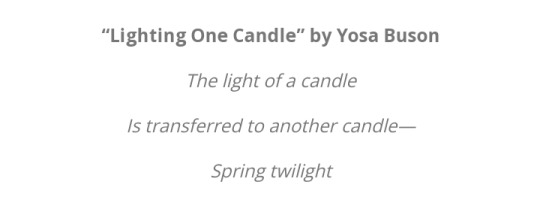
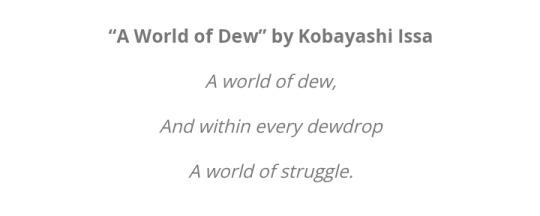

Sonnet: Traditionally, the sonnet is a fourteen-line poem written in iambic pentameter, employing one of several rhyme schemes, and adhering to a tightly structured thematic organization. The two main types of sonnets are the following:
• Shakespearean (or English) sonnet: three quatrains (4 lines) and a couplet (2 lines). Rhymes are ABAB, CDCD, EFEF, GG
• Petrarchan (or Italian) sonnet: divided into two stanzas, an octave (8 lines) followed by a sestet (6 lines). Rhymes are ABBAABBA + CDECDE or CDCDCD
Limerick: A limerick is a form of verse, usually humorous and frequently rude, in five-line, predominantly anapestic trimeter with a strict rhyme scheme of AABBA, in which the third and fourth lines are typically shorter.
Examples:


Elegy: A melancholy poem that serves the purpose of a lament for or a celebration of a deceased person.
Examples:
Elegies, Book One, 5 BY CHRISTOPHER MARLOWE
Lycidas, BY JOHN MILTON
Because I could not stop for Death, BY EMILY DICKINSON
Ode: An ode is a lyrical poem that expresses praise, glorification, or tribute, with the subject matter being a person, event, or idea. Classic odes contain three sections: a strophe, an antistrophe, and an epode—effectively a beginning, middle, and end.
Example:
Ode on a Grecian Urn, by JOHN KEATS
Concrete poem: Also known as visual poetry, it is essentially poetry which is shaped in a certain way which adds to its meaning.
Found poem: Found poetry is a form of poetry in which you create a poem by cutting up, remixing, or otherwise transforming an existing piece of text. (you can use dialogue from the show/scripts?)
Blackout poetry: Blackout poetry is the process out taking an already existing piece of text and blacking out the words save for a few select ones that take on new meaning.
#writing#writing poetry#poetry resources#poetry#poetic forms#how to write a poem#writing resources#resources#insp#buddie poetry event#poemsbybuddie
81 notes
·
View notes
Text
Hazuki Izumi (Reno Komine) stands on the edge of a rooftop looking out at the city beneath her. A clutter of competing architecture styles and buildings at various points of development: scaffolding, newly-built, maturing, declining, abandoned, condemned. Traffic lights glow, cars drone, and roads curve. A web of powerlines connects every part of the city. Hazuki is deep in thought, contemplating something or other, almost as if she’s listening to something we can’t quite hear. Her friend Mao (Shinsuke Aoki) notices the rooftop figure and approaches her as he becomes concerned that she might jump.
This scene takes place in August in the Water (1995) but variations of it can be found in a number of Japanese films and anime of the late 1990s to early 2000s. At the time of release these films and series belonged to different genres and production cycles yet retrospectively we can identify a fascinating pattern of imagery, themes, characters and even locations that recur to form an enigmatic genre called denpa. Little has been written about it in English, so allow me to venture forward.
‘Denpa’ is a Japanese word that means electromagnetic wave or radio wave. Within the genre, characters tune into these waves and feel their effects: they sense things, hear voices and see spectres, indeed the stories of Chiaki J. Konaka begin this way, including his Lovecraft-inspired psychological horror Serial Experiments Lain (1998) and Marebito (2004). The characters are susceptible to the waves due to alienation caused by their oppressive surroundings which is depicted through a distinct, industrial aesthetic: antennas, chain link fences, telephone poles, a web of powerlines across the sky, trains, manholes and sewers, grainy and distorted footage, a muted colour palette. This imagery reoccurs across denpa fiction, from the visionary anime of Satoshi Kon (Perfect Blue 1997, Paranoia Agent 2004) to the live-action poetry Shunji Iwai crafts out of adolescent cruelty (Picnic 1996, All About Lily Chou-Chou, 2001).
These bleak,alienated urban settings raise questions of tradition vs modernisation, mass-communication and a critical look at new technologies. Denpa situates these themes amongst references to folklore and the paranormal such as ESP, hauntings, aliens and spirits a combination explored by both the cult horror favourite Boogiepop Phantom (2000) and influential franchise starter Ring (1998). These supernatural beings are known to inhabit different realms and through electromagnetic waves these beings can cross over to our world, and humans can cross over to their worlds. The blurred lines between these spaces are illustrated with surreal imagery and experimental filmmaking. Such creative innovation can be found in the surreal psychological torment of Hideaki Anno (Neon Genesis Evangelion 1995-7, Love & Pop 1998, Ritual 2000) and in the breath-taking urban dreamscapes woven by Gakuryu Ishii (August in The Water, 1993’s Tokyo Blood). Within this cocktail of urban alienation and supernatural forces are plot points such as rumours, conspiracy, mental illness, and delusion often with cosmic and apocalyptic consequences, best embodied by the hypnotic horror of Kiyoshi Kurosawa (Cure 1997, Pulse 2001).
So far, denpa has only appeared as a loosely defined genre label on English-language databases for anime and videogames, on the occasional blog post, a handful of letterboxd lists and one lone essay [1]. It is at once both recognisable yet hard to define. I understand it on an emotional level, I can identify it as a vibe, yet I want to tease out the details and define it in more concrete terms: what makes something ‘denpa’?
The genre derives from ‘denpa-san’ or ‘denpa-kei’ a name for a type of person that emerged in the late 20th century. Think of denpa-san as analogous to ‘tin foil hatter’ – someone vulnerable to paranoia, conspiracy theories and delusions hoping that the foil will block out those invasive electromagnetic waves. Or maybe they’re already at their mercy, following instructions heard via the waves and doing unsavoury or even dangerous things. The term initially hit the mainstream consciousness in association with the 1981 ‘Fukugawa Street Murders’ where a 29-year-old man indiscriminately stabbed passers-by, killing several people and injuring more. The highly-publicised trial hinged on the controversial defence of insanity: the perpetrator argued that they were driven to murder after years of torment from electromagnetic waves [2]. Over time the term expanded to become associated with creepy, unpopular people in general, those on the fringes of society with unusual quirks and obsessions.
It is here that the term overlaps with another: ‘otaku’. A social outcast who obsesses over a hobby to the detriment of their social life. Think ‘geek’ but usually uttered with more contempt. Otaku is typically associated with anime, but contrary to popular belief can be about many subjects from videogames to cars. What ties them together is the negative effect it has on the self. Much like denpa, the term otaku gained traction in association with a horrific crime; in the 1990s it was elevated from merely a pejorative label to the centre of a moral panic in relation to the years-long trial of a serial killer nicknamed by the media as ‘the otaku killer’ for his extensive video collection of pornography and horror films [3]. In the years since, the collective otaku have shaken off the worst of these associations and become a phenomenon as they developed a distinct culture and became a major economic force that has been embraced by the media they obsess over. On the darker end of the subculture some favour the fantasy world of their hobby over the real world and get lost in it, which in itself has become a common denpa narrative with an iconic example being the idol otaku in Perfect Blue.
Critics ascribe the emergence of denpa-san and otaku to society at the time. The Japanese economic bubble burst in 1991 and the decade that followed became known as ‘The Lost Decade’. The population faced a recession which stunted young people as they came of working age. And yet Japan was known on the global stage to be at the forefront of home electronics and new technology. This was in tension with traditions of the past and complicated their national identity as new cultural connotations outpaced traditional ones posing the question: can an old culture survive as a new one emerges?
The development of these new technologies also introduced new issues as they quickly became part of everyday life. Camcorders in every hand, phones in every pocket, so easy to use that soon everyone had one without knowing how they really worked. Life was changing as there was now constant recording, growing access and intimate conversations were now held not in person but via phones and on internet forums. As people became increasingly reliant on these technologies, people began to wonder, what is the existential cost of these new conveniences?
From moral-panics and national identity crises to new technologies denpa fiction responds to this new cultural landscape.
The war between tradition and modernization often forms the backdrop of denpa fiction in urban spaces where a dedicated few keep old customs alive, while others push on for progress. Gakuryu Ishii (previously known as Sogo Ishii) depicts the tension of this conflict well in August in the Water where participants of the centuries-old festival in Hakata pulse through the city in historical costumes with traditional matsuri floats surrounded by modern buildings and stopped traffic; Ishii finds strange beauty in the cityscapes that engulf and imprison his characters. Investigations lead Detective Takabe (Koji Yakusho) in Cure to abandoned buildings and disused factories which signal the failure of a once-promising industry. In Love & Pop and Tokyo Blood, supporting characters are construction workers who signify this changing landscape as they meet on noisy building sites that are the eyesore we must endure for another dubious future.
The rooftop is a recurring location for these films. It can be a place for a clandestine conversation with a confidante, or a place for solo contemplation. The sight of a lone person on a rooftop can be startling to passers-by: the threat of suicide looms and in denpa often does happen. Cinematographically speaking it’s an opportunity to view an urban vista: the buildings, antennas and powerlines that populate the skyline. Again and again characters are drawn to the rooftop where they can get the clearest signal to the electromagnetic waves that mesmerise and influence them.
Alternatively, the clearest signal can be found by going right to the source. In Serial Experiments Lain we meet Lain’s father (Ryusuke Obayashi) at his impressive 6 monitor desktop and over the course of the series Lain’s (Kaori Shimizu) simple computer set-up evolves to be larger and larger. A soundscape is built from keyboard tapping, mouse clicking and monitors gently beeping. Denpa characters are often found hunched over a desk or workstation in the dark, the only light source being the glow of a screen or the small bulbs of a switchboard that gently whir as a pen scratches while detailed notes are being made. It’s an image with unhealthy connotations indicating obsession and someone losing touch with the outside world. In Boogiepop Phantom, the deskbound character is a videogame otaku finding solace in a fictional fantasy world. In Cure they’re a detective and in Ring a journalist whose respective investigations turn fanatical as they uncover disturbing histories. In each instance the foundations of their worldview will soon be shaken and their mental health questioned as conspiracies and paranormal explanations become more and more likely. Are the characters’ paranoid, or are they seeing things clearly for the first time?
These paranoid thoughts or deteriorating mental states are often heard through voice-over narration. Depending on the film the voice-over could be the trademark psychological introspection of Neon Genesis Evangelion, or the expansive philosophical musings of August in the Water or even the sinister and somewhat incoherent rambling of Marebito. Though superficially different, what they share is a painfully personal and poetic type of soliloquy.
Alongside narration, different psychological states are expressed through surreal imagery and experimental filmmaking, which often leads to a striking use of mixed-media with live-action moments in anime. In Boogiepop Phantom, a drug-addled videogame otaku experiences visions which are depicted by heavily edited live-action footage in a break from the traditional animation of the series. In Serial Experiments Lain there are animated character figures over live-action backgrounds which has the uncanny effect of blurring the lines between the different worlds that Lain traverses. In the case of Neon Genesis Evangelion: End of Evangelion, the sequence of live-action footage breaks the diegetic barrier between the text and audience, seeming to directly address not only the delusions of its’ characters but its own otaku fandom.
This subtle sense of self-awareness can be seen in the eerie experience of watching characters watching screens. Frames within frames or looking at a picture within a picture, voyeurism becomes infinite. New technologies allow people to see people through a thick glass lens or a pixelated screen. Distant yet paradoxically seeing each other more intimately than ever. In Perfect Blue this newfound intimacy fuels the obsessions and delusions of both Mima and her otaku fan.
The spectre of denpa is not limited to Japan. The same themes and same motifs can be found in English-language films from around the same time. There is Donnie Darko (2001), Richard Kelly’s film about a schizophrenic teenager who is told to commit crimes by a phantom in a rabbit suit and whose survival of a near-death-experience has apocalyptic consequences. You can find denpa in the films of M. Night Shyamalan: from the delusion of Bruce Willis in The Sixth Sense (1999), to the haunting image of mass rooftop suicides in The Happening (2008) and to the potent mix of aliens and religion in Signs (2002). Even in the music video of Eminem’s Stan (2000)– in which a disturbed otaku hunches over a desk under a perpetual raincloud. When I recognise denpa motifs in films made outside Japan, I begin to think of denpa less as a genre and more as a zeitgeist. A restless, nihilistic gen x moan of exasperation. That feeling of living in The Matrix (1999); groaning at the end of the century and looking to the new one with only pessimism. Yes, there are new technologies but there are as many negative possible outcomes as there are positive ones. It seems inevitable that people will succumb to their worst impulses.
24 notes
·
View notes
Text
Angels When She Shuts Her Eyes - Mac Miller (Official Audio)
youtube
"Angels (When She Shuts Her Eyes)" by Mac Miller delves into the complexities of love and the intoxicating effects it can have on an individual. The song captures the artist's vulnerabilities and desires while contemplating the uncertainty and potential risks involved in a romantic relationship.
In the first verse, Mac Miller reveals his struggles with addiction and the dichotomy between wanting to clean up his life and indulging in his vices. He acknowledges the pain and difficulty of his past, as well as the lost vision he once had for his future.
The pre-chorus expresses the allure of a particular woman in his life who serves as his source of comfort and escape from his emotional lows. She is portrayed as someone who can lift him up when he feels down and provides a sense of tranquility. The reference to filling his cup with purple implies the consumption of codeine, a common ingredient in the recreational drug cocktail known as "lean." However, it may also symbolize the purple liquid commonly associated with royalty, highlighting the elevated state he feels when with her.
The chorus emphasizes a plea to the woman not to let go of their intense connection. Mac Miller acknowledges that their love is intense and unpredictable, addicting him in a way that could ultimately be destructive. Despite the potential harm, he warns her of the power love holds and expresses hope for a lasting bond.
In the second verse, the artist reflects on his idealized vision of love and a longing for a soulmate who appreciates him beyond physical attributes. He dreams of a deep connection where they can freely express their feelings and be true to themselves. The lyrics suggest a desire for a love that defies societal expectations and norms.
Overall, "Angels (When She Shuts Her Eyes)" explores the intoxicating nature of love and its potential dangers. It serves as a reminder of the euphoria and vulnerability that come with deep emotional connections.
Acrostics British Gnosticism Manichaeism Biblical Apocrypha: Sylphs Archon of Jupiter, Crown Conjunction; An acrostic is a poem in which the initial letters of each successive line form a word, phrase, or pattern. Phrase 18 Roses: To tell a loved one to stay young and beautiful. (United Kingdom Watchers). We can think of several reasons. (1) It may be an artistic device used to add a certain beauty to the psalm, as rhyme does in our poetry. Forbidden Knowledge From Heaven: Concrete Rose Philosophy (CAAB: Culture, Art, Aesthetic, Bohemian; 5 Senses City, Selective Sensory Development, Distorted Sensory Play, Sensory Overload Asperger's, Culture Antagonist Liberal Arts), County Speech Pharmakeia (Dionysian Mysteries, Sacraments, and Entheogens), Heavenly Ascension, Jupiter’s Secret (Crown Conjunction) and Virilizization Procreation (Martians, Elastic Physique, Iron Biometal Research, Iron and D-asparatic Acid Diet), Tudor Currency, Azrael Covenant of Death and Romance with Roses and Diamonds, YHWH Tudor Rose Angel Syncretism, Tudor Rose Wings Transfer 18 Roses (Spirit Activation). Poetry Theme is Angels (When She Shuts Her Eyes) by Max Miller
Theistic Satanism: Theistic Satanism, otherwise referred to as religious Satanism, spiritual Satanism, or traditional Satanism, is an umbrella term for religious groups that consider Satan, the Devil, to objectively exist as a deity, supernatural entity, or spiritual being worthy of worship or reverence, whom individuals may contact and convene with
Manichaeism teaches an elaborate dualistic cosmology describing the struggle between a good, spiritual world of light, and an evil, material world of darkness.[8]
Archons: They are often depicted as evil, malevolent, and obstacles to spiritual enlightenment. Archons in Gnosticism are believed to be celestial beings responsible for creating and maintaining the physical universe, and are seen as obstacles to spiritual enlightenment. They are often depicted as powerful, malevolent, and deceitful beings that try to keep humanity trapped in the physical world.
Sylphs: "the wild but poetical fantasies”, hyper-urbane, Genius, Sylphs, he says, are rougher, coarser, taller, and stronger, than humans, devils
The Heavenly host (Hebrew: צבאות ṣəḇāʾōṯ, "armies") refers to the army (or host) of Yahweh, as mentioned in both the Hebrew and Christian Bibles, as well as other Abrahamic texts.
Spartan women had more rights and enjoyed greater autonomy than women in any other Greek city-state of the Classical Period (5th-4th centuries BCE). Women could inherit property, own land, make business transactions, and were better educated than women in ancient Greece in general. To contemporaries outside of Sparta, Spartan women had a reputation for promiscuity and controlling their husbands. Spartan women could legally own and inherit property, and they were usually better educated than their Athenian counterparts.
Commercialism
A system of Social and economic organization in which financial profit is valued above any other criterion or consideration.
Arsenio Boxing Movement
Aesthetics, Athletics, and Agriculture (Life Drawing Modelling and Tracksuits with Outerwear, Boxing, Agriculture Mediums, Iron Metabolism)
Arsenio Anatomy
For Force-Velocity Curve Replace Power with Elastic for Fascia Type IIx Muscle Fibre with Dynamic Effort Method, Scapular Rings Gymnastics, Long Jump Isometric-Plyometric, Long Jump Isometric-Mobility, Isometric-Dynamic Plank, Long Jump Isometric Stretching, Leucine, Hydrolyzed Collagen, Keto BHB, and Iron Supplements with Lidocaine Numbing Cream and Tramadol Painkiller; Duck, Sheep Dairy, Rabbit, Beans, Spinach, And Potato for Iron Metabolism
Shoulder Roll Brawler
Pocket Fighting and Clinching. Use different Jab and Power Shot Types for Bladed Guard Manipulation for Signature Stance. The shoulder roll is a defensive move in its essence, one you can get to from any position or stance. It allows you to tuck your chin behind your shoulder to avoid your opponent’s punches.
Arsenio Chain Model
Pay-per-view Conglomerate, Magazines with Gyms, Solo Promotion and Teams Demotion Daily Fantasy Sports Rakes and Purses, Boxing Economy Magazines, AgriMediums for Rural Area Commerce, AgInvestors, Life Drawing Modelling and Tracksuits with Outerwear for 1% Class Interaction, British Boxing Museum, Memoir and Documentaries, Brain Donation, Anatomy and Iron Metabolism Meta-analysis
Arsenio Slaps
Heavy Hands; Imagine you are an elastic band wrapped around a pole with the ends out. When the front end is tugged, that's your front hand and reverse front hip rotation. When the back end is tugged, that's your rear hand and reverse back hip rotation. Remember to use Obliques and Lats. Think of this motion as a coil-flex-release. Closed System: A closed system is a physical system that does not allow transfer of matter in or out of the system. Torque: Torque is the rotational equivalent of linear force. It is also referred to as the moment, moment of force, rotational force or turning effect, depending on the field of study. The concept originated with the studies by Archimedes of the usage of levers. Impulse: impulse is the integral of a force, F, over the time interval, t, for which it acts. Since force is a vector quantity, impulse is also a vector quantity. Impulse applied to an object produces an equivalent vector change in its linear momentum, also in the resultant direction.
Arsenio Mechanics
Stance: Manipulated Shoulder Roll with Distinct Jab and Power Shot Arsenal Footwork: Tap Dance and Gallops, Combo Targets: Body Inverted V and Head with Center Line and Flanks, Combo: Burst Jab Covers Power shots and Jab ends Combo, Footwork: Cross Step and L-Step
Aresnio Boxing Museum
Theatre and Library, Sculpting Modelling (Scapula exercises works Traps and Serratus Anterior), Sculpting Courses, History Exhibit
Aresnio Decentralized Gambling Economy
Pigou Effect, Corporate-Capital Gains Tax Haven, High Stakes Minimum Buy In, Domestic: Boxing, Retirement: Boat Racing, Residency Program for Tax Benefits
Arsenio Magazine Structure
Weight Classes Teams-Boxing Clubs: Promotions (Solo) and Relegation (Teams) Tournaments and Exhibition ex. Team A Welterweight vs Team B Welterweight Relégation Exhibition and Boxer 1 from Team A vs Boxer 1 from Team B Promotions Tournaments
Arsenio Accent
Glottal Stops Consonants and Shwas
18 Roses
3 notes
·
View notes
Note
hi!!! thank you for all the amazing commentary you are providing on the state of art — i’ve been following you for years and you’ve done so much to expand my understanding of the world. i’m a (brand new) 4th grade teacher and i’m currently designing a poetry unit for my students. i really want to emphasize to them that poetry is an incredibly expansive art form that can be created using myriad tools, forms, etc. i was wondering if you have any advice on how to incorporate that into the curriculum… or if you have any other advice on teaching kids to read/write/experience/analyze poetry. thank you :)) ❤️❤️
oh, that's great to hear, thank you!
I don't think there's anything wrong with all the standard culprits (e.g. acrostic poems, concrete poems) especially if you want your kids to write poetry—it gives them a basic framework to start with and can help prevent them from getting stuck.
I usually start with a very simple contextualisation of English poetry: a basic rundown of rhyme patterns including the couplet and the sonnet, and the idea that certain subjects belonged with certain forms (kings and legends and the epic in heroic couplets, the sonnet and shorter, more contained little stories); and then talk about how people "broke" those rules by writing metered poetry about everyday people. Ask if they agree that certain forms are fancier than others and should go with more "important" subjects, or if they agree that there's no point writing poetry about ordinary people, or if they think there should be "rules" that can't be broken.
If you're going to have them write a sonnet at that point, I wouldn't worry too much about meter, which is a bit abstract to explain to a classroom of 4th graders—just give them the rhyme scheme of a Shakespearean sonnet to play around with.
From there I'll move into free form poetry, and then to "process" poetry that's more "random" (such Brion Gysin's poetry cut-ups). Pair this with a basic discussion of what context poets were responding to when coming up with these techniques (i.e. modernism and a breaking of the rules of form across art mediums) to help pair a poetic form with the "idea" behind it.
Having kids make found poetry is a good way to make poetry seem fun and tactile and immediate. I would recommend cut-up over blackout, since cut-up is more hands-on, and when kids write blackout poetry the final piece tends to just be a summary of the text they started with, which isn't very exciting. Use a source text that's not so dry that it's hard to get something "literary" out of—maybe using old books (outdated textbooks, anything in very poor shape that a local library is giving away) could give a thrill of the illicit to the whole thing.
Keep asking if they think this is a good way to make a poem, and why or why not. Ask if they prefer writing with rhymes or without rhymes, and if they prefer coming up with all of the words or rearranging them. Ask why a poet might choose one style of poem over another.
A good website on dadaist &c. poetry with some good tools and exercises that I regularly consult is languageisavirus.com
26 notes
·
View notes
Note
20, 56, and 71? (I'm very curious about that last with your current project)
Thank you! I can always rely on you to indulge me when I want to play an ask game 🥰
It got a little long so I'm gonna put in a break to not ruin people's feeds.
Before the break though, if you want to play "get to know your fic writer" just pick your question(s) from this list!
20. Have you noticed any patterns in your fics? Words/expressions that appear a lot, themes, common settings, etc?
There are a lot of possible answers to this one, but a few off the top of my head:
I can never resist a little alliteration.
It's something I always have to rein in a bit, but if I want to emphasize something I will regularly repeat myself. Not word for word, but restating it. I think this might be related to the way I speak IRL and the ADHD need to over-clarify. But it's a thing I've seen other writers do also!
I love an image, and literally require them to write the way the human brain requires oxygen. Every shorter piece I've posted was directly inspired by/is heavily dominated by a single image, to the point that I sometimes feel like it's the poetry part of my brain that writes anything under 2000 words.
56. What’s something about your writing that you pride yourself on?
The nouns. People, places, and things, as in introducing a character, evoking a place and describing a thing. Until fairly recently, those were my writing raisons d'être tbh. An image would lead me to one or more of them, and I'd get lost in them, but my motivation would always peter out around the time I needed stuff to like, happen. Plot was always, always an afterthought (which is a big reason for the poetry part of my brain I mentioned in the previous answer).
71. When it comes to more complicated narratives, how do you keep track of outlines, characters, development, timeline, ect.?
Hoo boy. What a question. I've never committed to a longfic the way I have with FtF so I'm still figuring it out. When I was still figuring out which tropey longfic I wanted to work on in this fandom I actually started with a different one (a "Stede gets captured by Blackbeard before he has the chance to get gut-stabbed by the Spanish" thing), which is why you'll confusingly see FtF posts tagged with #baby's second longfic. But one thing working on that first one helped me with was figuring out I need to stay on top of it all.
The short version is "a doc for everything and everything in a doc."
I have like, a "beat sheet" for the big story beats and a big messy "brain dump" sort of document, so that I can note new things down without getting distracted by where they're supposed to go. The latter is also where the earliest writing takes place, and how I learn what shape something could take.
When things start to coalesce a bit, there's a new file for every chapter that I can see on the horizon (like for FtF I've gone as far as Chapter 6). Doing it any other way would be literally unworkable for me. Besides just like, limiting the scale of whatever I'm looking at at a given moment, it's also handy to be able to cut and paste things around when I need to change where something falls in the timeline. And because this fic is The Way That It Is, I also have separate documents for things like flashbacks and the academic blurbs, although I will copy the latter to their requisite chapter doc when I figure out where I want them.
While writing this reply, it's occurred to me that it might be a good idea to have a document just for things that have been set in stone, like dates and ages and locations etc. Just to keep my facts straight. That's kind of a big reason I've been posting chapters as soon as they're written instead of waiting till I had a backlog - I needed to get some things set in stone so I wouldn't be tempted/able to keep changing everything. The more concrete details I nail down the faster (read: not fast) this thing gets written.
This has been so much fun and super educational to think about all this stuff so thank you so, so much for asking ❤️❤️❤️
2 notes
·
View notes
Text
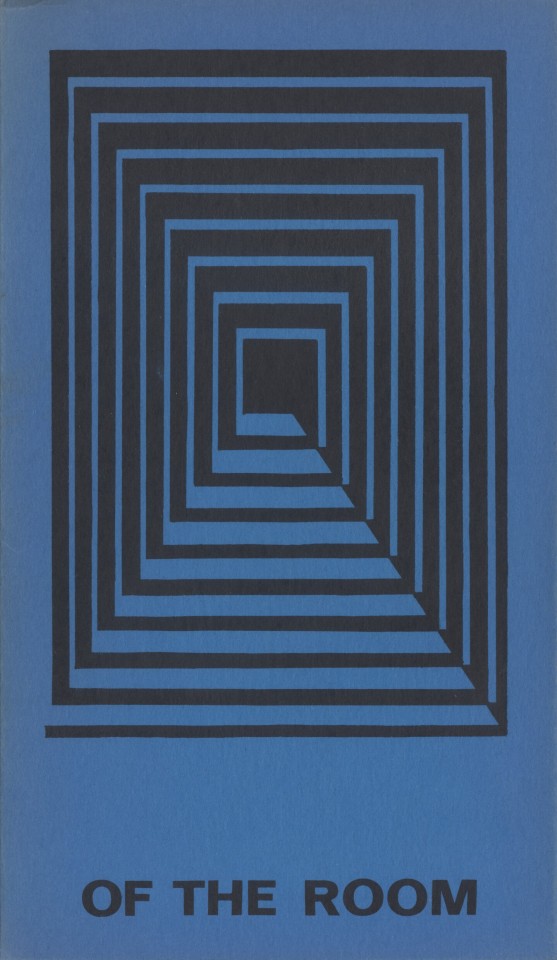
bpNichol, The Other Side of the Room. Poems, 1966-69, Wraparound Cover Art by Barbara Caruso, Weed/Flower Press, Toronto, 1971, Edition of 300 [room 3o2 books, Ottawa. © bpNichol / The Estate of bpNichol]
#graphic design#art#poetry#concrete poetry#visual poetry#geometry#pattern#book#cover#book cover#bpnichol#barbara caruso#weed flower press#room 3o2 books#1960s#1970s
153 notes
·
View notes
Photo

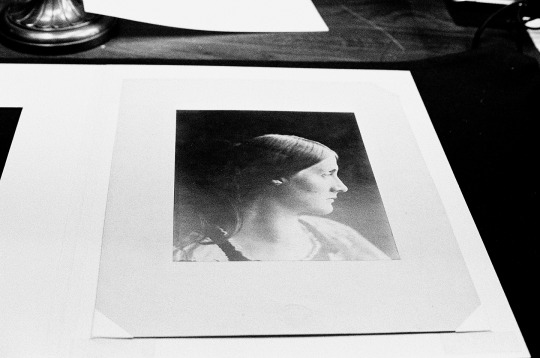


Walking with Nandita
By Moyra Davey
Here was the soup. It was a plain gravy soup. There was nothing to stir the fancy in that. One could have seen through the transparent liquid any pattern that there might have been on the plate itself. But there was no pattern. The plate was plain.
—Virginia Woolf, “A Room of One’s Own” (1929)
New York City, 157th Street
I am trying to think “language or hunger,” but I inevitably supplant hunger with eating, not eating, and shitting, all of which differ from hunger. Hunger is abstract, and my mind goes to things that are concrete.
Alejandra Pizarnik’s Diarios are pure poetry. I made the rounds of Paris bookstores till I found a single copy of the beautiful José Corti paperback with Pizarnik’s face on it. She is pulling a book off a high shelf and staring back at the camera, at us. I kept this book on a skinny Chippendale bookcase next to my bed with the cover facing out for several years so that I might meet her soulful gaze daily. I read a hundred pages or so before standing the book up like that. I was blown away by the diaries, but they are also inescapably dark. For Pizarnik, suicide was not a question of if but when, and she wrote about it almost daily, as though death was her little friend. She envied Virginia Woolf.
Hungry, thirsty, in need of stimulants, Pizarnik’s appetites and cravings were outsized. She hated herself after lunch and dinner, and wrote: “To not eat I must be happy. And I cannot be happy if I am fat.”
In my bones I understand Pizarnik’s tautology, but my mind needs to metabolize it over and over. I memorize it; it slips away.
Here is Alison Strayer’s lovely spin (Pizarnik’s idea somewhat teased out): “to write, driven by inspiration, you have to be thin and fleet, and to be thin and fleet you have to write, driven by inspiration. A conundrum.”
In her 1975 film Je tu il elle (I, You, He, She), Chantal Akerman shovels powdered sugar into her mouth while writing lying down—she is composing and revising a very long letter. The entire bag of sugar is ingested, spoonful by spoonful, to fuel the manic, around-the-clock writing. As viewers of her film, we bear witness to what is surely one of the most sustained and inspired moments of self-abuse in the service of avant-garde, materialist cinema.
Conversely, when Virginia Woolf succumbed to periods of so-called madness, the treatment consisted of denying her both language and hunger. She was not permitted to read or write, and she was made to consume excessive quantities of meat and milk. Her intellect was starved, and her naturally thin frame was fattened against her will. According to her great-niece, Emma Woolf, the regimen consisted of: “Four or five pints of milk daily, as well as cutlets, liquid malt extract and beef tea.”
Woolf appears gaunt in some of her photographs. Like many writers, she probably didn’t experience hunger when she was writing. She was prolific, and it is likely that language evacuated bodily hunger for a good portion of her life. Her great-niece has speculated that Woolf was anorexic, but if that’s the case I’d wager only in the sense that she had no appetite. Though who knows. Forced to bulk up, she might have developed a fear of fat.
Woolf wrote about food, most famously in “A Room of One’s Own.” She describes the bland meal served in the dining hall of a women’s college and speculates on the necessary (and there absent) connection between stimulation of the palate and stimulation of the mind. In “Evening over Sussex” she describes the comfort food that awaits her after a long day of travel and walking, and no doubt writing parts of the namesake essay in her head.
In the episode of Ulysses known as “Calypso,” which begins with a very large printed “M,” Leopold Bloom, after his breakfast of grilled kidneys, famously retires to the outhouse where he reads two columns of the newspaper and produces one or two excremental pillars of his own. Evacuated and grateful, he nonetheless envies the writer of the article who was paid “at the rate of one guinea a column.”
American artist Pope.L masticates the Wall Street Journal and allegedly washes it down with milk while sitting atop a toilet perched on a tower.
Canadian poet Elizabeth Smart, living in England, makes a New Year’s resolution list for the year 1945. Below are the first seven items listed:
1) Keep a diary or Daily Notebook.
2) Keep Accounts and never spend more than £20 a month on living (and partly living).
3) Keep the children Prettily dressed always.
4) Keep Everything Clean.
5) Answer all letters within three days.
6) Keep bowels open.
7) Have a baby. [checked] Sebastian 16 April 1945.
Discipline, money/frugality, cleanliness, punctuality, open bowels (which I’m sure Smart meant literally, but I’d also infer an implied wish for writing to flow more readily), and having a baby form the top priorities. Smart had four babies all by the same man, George Barker, who’d never consent to live with her, nor would he let her go, thus keeping her in a decades-long state of unrequited craving and misery.
Writing at the end of her life, in a state of relative isolation, photographer Julia Margaret Cameron was clear about her needs: “I feel it is as necessary to give a hungry heart a letter as a hungry body a slice of bread.”
continued...
19 notes
·
View notes
Text





The Portland Bridge Book
by Sharon Wood Wortman with Ed Wortman
Third edition of The Portland Bridge Book is like an old faithful bridge that's been restored by a dedicated crew of specialists to increase its carrying capacity for the public's enjoyment. Over a span of 225 pages (50 percent larger than the second edition and more than twice the size of the first edition), this edition delivers: Profiles 15 highway bridges and four railroad bridges across the Willamette and Columbia rivers in the metro area. Each structure's general history, technical details, source of its name, and more are explained in accessible language. 150 historic and large format contemporary photographs, many published for the first time. Annotated drawings by Joseph Boquiren showing Portland's movable bridges in operation. How & Why Bridges Are Built, written by Fremont Bridge field engineer Ed Wortman. Expanded and localized glossary of bridge termsPortland transportation history timeline, truss patterns, bridge poetry, lyrics.
Images 1 & 2 from the Portland Bridge Book. Image 3 is the cover of the book.
Snippets
Multnomah County owns four of the five large movable bridges: Hawthorne, Morrison, Burnside, and Broadway bridges, as well as Sellwood and Sauvie Island bridges.
Oregon Department of Transportation (ODOT) owns state and interstate highway structures, i.e. Ross Island, Marquam, Fremont, St. Johns, Oregon City, and Abernethy bridges, and across the Columbia River, Glenn Jackson Bridge and in a joint agreement with WA state, the Interstate Bridge.
Other notable bridges in Portland Oregon that do not cross the river.
Balch Gulch Bridge on Thurman Street in Northwest Portland, built for the 1905 Lewis and Clark Exposition. One of about 150 highway and pedestrian bridges owned and maintained by the City of Portland, this unusual hanging deck truss is the oldest highway deck truss bridge in Oregon.
Vista Avenue Viaduct, a 248-foot open-spandrel reinforced concrete highway arch located 128 feet above SW Jefferson St on the way to US Highway 26 in Portland's West Hills.
Tilikum Crossing: Portland's Bridges and a New Icon by Donald MacDonald & Ira Nadel (2020)
Portland, Oregon's innovative and distinctive landmark, Tilikum Crossing Bridge of the People, is the first major bridge in the U.S, carrying trains, busses, streetcars, bicycles, and pedestrians- but no private automobiles. When regional transportation agency TriMet began planning for the first bridge to be constructed across the Willamette River since 1973, the goal was to build a something symbolic, which would represent the progressive nature of the Twenty-First Century. Part of that progressiveness was engaging in a public process that involved neighborhood associations, small businesses, environmentalists, biologists, bicycling enthusiasts, designers, engineers, and the City Council. The result of this collaboration was an entirely unique bridge that increased the transportation capacity of the city while allowing Portlanders to experience their urban home in an entirely new way—car-free. In this book, the award winning architect of Tilikum Crossing, Donald MacDonald, and co-author Ira Nadel, tell the story of Portland through its bridges. Written in a friendly voice, readers will learn how Portland came to be known as "The City of Bridges" and the home to this new icon in the city's landscape. MacDonald uses 98 of his own drawings to illustrate the history of Portland river crossings and to show the process of building a Twenty-First Century landmark
Image 4 is the Tilikum Crossing book cover. Image 5 is a photo of the bridge itself.
youtube
Short video: Aerial footage of some of the bridges in Portland, Oregon. Relaxing views of the Broadway, Fremont and Steel bridges. Apr 26, 2021
2 notes
·
View notes
Text
[Blog #10] Spring 2023, Plath, Sexton and Lowell vs Olds, Flynn and Davis
Today, I am comparing and contrasting early Confessional poets -- Sylvia Plath’s “Lady Lazarus,” Anne Sexton’s “Wanting to Die” and Robert Lowell’s “Skunk Hour” -- to their Confessional contemporaries -- Sharon Olds’ “My Son the Man,” Nick Flynn’s “My Mother Contemplating Her Gun” and Olena Kalytiak Davis’ “Not This”.
For reference, confessional-style poetry or confessionalism is poetry that often incorporates first-person perspective to detail psychological struggles such as mental illness and/or childhood traumas.
Before I analyze the similarities and differences between those six poems, I would love to greet anyone who happens to stumble upon this blog post.
This is the link to my first blog post on Ada Limon’s The Carrying (2018):
My professor assigned a poetry book collection or individual poems every other week. My main objective was to dissect a few poems that left an impression on me while using his T.R.I.F.F.I.D. method.
Tone: the voice, mood, or attitude the reader believes the author is conveying through subject and word choice.
Rhythm: the pattern and beat between the stressed and unstressed word syllables.
Imagery: the details told through the five senses (touch aka physical, sound aka auditory, sight aka visual, taste aka gustatory and smell aka olfactory).
Figure: or figure of speech, is the non-literal expression of language. Figures of speech include hyperbole, irony, metaphor, simile, anaphora, antithesis and chiasmus.
Form: the way a poem is presented on paper or a screen. Think of how the author physically shapes the poem -- the use of dialogue, line spacing, paragraph breaks, rhythms and patterns.
Idea Density: how the author expresses their ideas throughout their poem. Can be literal (concrete) and/or figurative (vague or hidden).
Diction: the word choice and arrangement within a piece.
Part I:
The most noticeable difference between early and contemporary confessional poems are their forms. For example, both Sylvia Plath’s “Lady Lazarus” and Anne Sexton’s “Wanting to Die” have 3 lines per stanza, while Robert Lowell’s “Skunk Hour” has 6.
On the other hand, Sharon Olds’ “My Son the Man” is one long stanza compose of 15 lines; Nick Flynn’s “My Mother Contemplating Her Gun” is a bit harder to deduce where a stanza starts and end, but it seems to vary between 1–3 lines per stanza. Olena Kalytiak Davis’ “Not This” starts at 2 lines, then 11, and shifts back to 2 lines for the last three stanzas.
Part II:
I feel as though I can’t quite compare and contrast the early and contemporary poets’ idea density because they all similarly discuss mental health awareness/topics. Plath’s “Lady Lazarus” (Lazarus means a person who is resurrected from the dead) reveals the narrator’s (Plath’s) third suicide attempt by age thirty:
I have done it again.
One year in every ten
I manage it——
(...)
And I a smiling woman.
I am only thirty.
And like the cat I have nine times to die.
This is Number Three.
What a trash
To annihilate each decade. (1-3, 21-24)

Lowell’s “Skunk Hour” the narrator admits to his declining mental health -- feeling crazy, alone and depressed, so much so, he compared his state of mind to Hell:
My mind’s not right.
A car radio bleats,
“Love, O careless Love. . . .” I hear
my ill-spirit sob in each blood cell,
as if my hand were at its throat. . . .
I myself am hell;
nobody’s here— (30-36)
Sexton’s “Wanting to Die” is vaguely similar in topic to Plath as they both discuss “suicide,” though Sexton is more on the nose than Plath. In reference to the title, the narrator confesses to her desire to commit suicide:
Since you ask, most days I cannot remember.
I walk in my clothing, unmarked by that voyage.
Then the almost unnameable lust returns.
Even then I have nothing against life.
I know well the grass blades you mention,
the furniture you have placed under the sun.
But suicides have a special language.
Like carpenters they want to know which tools.
They never ask why build. (1-9)
Olds’ “My Son the Man” the narrator confesses that she is afraid of her son growing up and becoming his own person outside of her control/influence (maternal fears).

She compares herself to the chains strapped on Houdini, while her son is compared to Houdini himself:
Suddenly his shoulders get a lot wider,
the way Houdini would expand his body
while people were putting him in chains. It seems
no time since I would help him to put on his sleeper,
guide his calves into the gold interior,
zip him up and toss him up and
catch his weight. I cannot imagine him
no longer a child, and I know I must get ready,
get over my fear of men now my son
is going to be one. This was not
what I had in mind when he pressed up through me like a
sealed trunk through the ice of the Hudson,
snapped the padlock, unsnaked the chains,
and appeared in my arms. Now he looks at me
the way Houdini studied a box
to learn the way out, then smiled and let himself be manacled. (1-15)
Eventually, like all traps, Houdini figures them out and escapes, which is what the narrator fears her son will do to her when he matures.
Again, Flynn’s “My Mother Contemplating Her Gun” is similar to Plath and Sexton’s poems as it deals with the topic of suicide; as the title implies, the narrator is the mother.
Throughout the poem, the mother discusses the gun -- the act of suicide -- as insignificant or easy by down-playing the severity and adding colorful descriptions to the gun:
I bought it
when I didn’t feel safe. The barrel
is oily,
reflective, the steel
pure, pulled from a hole
in West Virginia. It
could have been cast into anything, nails
along the carpenter’s lip, the ladder
to balance the train. Look at this, one
bullet,
how almost nothing it is—
saltpeter sulphur lead Hell
burns sulphur, a smell like this.
safety & hammer, barrel & grip
I don’t know what I believe. (9-23)
Lastly, in Davis’ “Not This,” the narrator reveals she regrets not appreciating the little moments of family time in the past since the family dynamic has change -- the children growing up and the narrator (possibly) falling out of love with their spouse:
i raised my kids, they
grew i lost two pasts–i am
not made of them and they
are through.
we forget what
we remember:
each of the five
the fevered few
days we used to
fall in love. (10-19)

What did I learn?
The most noticeable difference between early and contemporary confessional poems are their forms; early poets stuck to a rigid line count, while their successors are more free-flowing.
Moreover, they all discuss mental health issues. Plath, Sexton and Flynn explore suicide in their poetry; Lowell, Olds and Davis wrote about varying topics: solitude, maternal fears and regret.
Whether early or contemporary, not all poets write about the same mental issues; even if two poets wrote about the same mental illness, they have differing voices, imagery, figures of speeches, etc.
Though, most confessional poets seem to share the same tone: melancholy, desolate, grim, mournful and pessimistic.
Spotlight Poet: Who is Sylvia Plath?
Some may only know Sylvia Plath by how she infamously died, rather than how she lived her life. I am here to correct that! Boston native Sylvia Plath specialized and was highly noted for her confessional poetry; her topics ranged from her mental struggles, self-image and familial and marital traumas. During her lifetime, Plath published two poetry collections: The Colossus and Other Poems (1960) and Ariel (1965).
One of her most well-known and studied poems is “Lady Lazarus” and “Daddy”. In the former, as discussed earlier, Plath confesses to her third suicide attempt, whereas in the latter, she recounts her patriarchal sufferings through her father’s death and the conflicting relationship with her husband (poet Ted Hughes).
In the end, Sylvia Plath’s poetry remained timeless and praised by her contemporaries and successors because of how relatable and descriptive her thoughts and emotions -- anguish, alienation and self-destruction -- are to the past and present literary communities.
For more information on confessionalism and poetry by Plath, Sexton, Lowell, Olds, Flynn and Davis, check out the links below:
Lastly, what are some of your favorite confession-style poems?
Feel free to share some below!
#poetry review#poetry book#poetry recs#Sylvia Plath#Anne Sexton#Robert Lowell#poems#early poetry#contemporary poetry#sharon olds#nick flynn#olena kalytiak davis#confessional poetry
6 notes
·
View notes